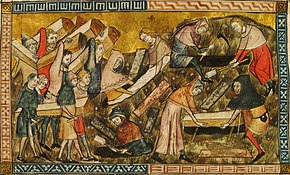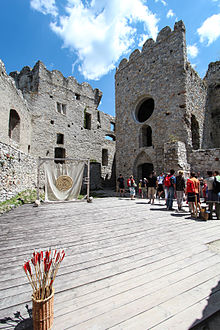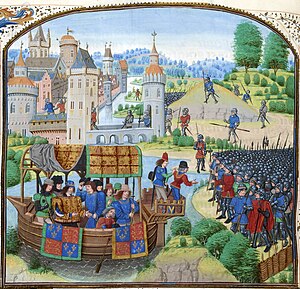The crisis of the Late Middle Ages was a series of events in the fourteenth and fifteenth centuries that brought centuries of European stability to a halt.
Three major crises led to radical changes in all areas of society:
demographic collapse, political instabilities and religious upheavals.
A series of disasters, beginning with the Great Famine of 1315–17 and especially the Black Death of 1347-1351, reduced the population perhaps by half or more as the Medieval Warm Period came to a close and the first century of the Little Ice Age began. It took 150 years for the European population to regain the levels of 1300.
Popular revolts in late-medieval Europe and civil wars between nobles within countries such as the Wars of the Roses were common—with France fighting internally nine times—and there were international conflicts between kings such as France and England in the Hundred Years' War. The unity of the Roman Catholic Church was shattered by the Western Schism. The Holy Roman Empire was also in decline; in the aftermath of the Great Interregnum
(1247–1273), the Empire lost cohesion and politically the separate
dynasties of the various German states became more important than their
common empire.
Historiography
The expression "Crisis of the Late Middle Ages" is used commonly in western historiography,
especially in English and German, and somewhat less among other western
European scholarship to refer individually or collectively to different
crises besetting Europe in the 14th and 15th centuries. The expression
often carries a modifier to refer more specifically to one or another
aspect of Late Middle Age crisis, such as the Urban Crisis of the Late Middle Ages, or the Cultural, Monastic, Religious, Social, Economic, Intellectual, or Agrarian crisis of the Late Middle Ages, or a national or regional modifier, e.g. Catalan or French crisis.
By 1929, French historian Marc Bloch was already writing about the effects of the crisis of the Late Middle Ages, and by mid-century there were academic debates being held about it.
In his 1981 article Late Middle Age Agrarian Crisis or Crisis of Feudalism?, Peter Kriedte reprises some of the early works in the field from historians writing in the 1930s, including Marc Bloch, Henri Pirenne, Wilhelm Abel, and Michael Postan.
Referred to in Italian as the "Crisis of the 14th Century", Giovanni
Cherubini alluded to the debate that already by 1974 had been going on
"for several decades" in French, British, American, and German
historiography.
Arno Borst (1992) says that it "is a given that fourteenth
century Latin Christianity was in a crisis", and goes on to say that the
intellectual aspects and how universities were affected by the crisis
is underrepresented in the scholarship hitherto: "When we discuss the
crisis of the Late Middle Ages, we consider intellectual movements
beside religious, social, and economic ones", and gives some examples.
Some question whether "crisis" is the right expression for the
period at the end of the Middle Ages and the transition to Modernity. In
his 1981 article The End of the Middle Ages: Decline, Crisis or Transformation?
Donald Sullivan addresses this question, claiming that scholarship has
neglected the period and viewed it largely as a precursor to subsequent
climactic events such as the Renaissance and Reformation.
In his "Introduction to the History of the Middle Ages in
Europe", Mitre Fernández wrote in 2004 that "[t]o talk about a general
crisis of the Late Middle Ages is already a commonplace in the study of
medieval history."
Heribert Müller, in his 2012 book on the religious crisis of the late
Middle Ages, discussed whether the term itself was in crisis, saying,
No doubt the thesis of the crisis of the late Middle Ages has itself been in crisis for some time now, and hardly anyone considered an expert in the field would still profess it without some ifs and buts, and especially so in the case of German Medieval historians.
In his 2014 historiographical article about the crisis in the Middle
Ages, Peter Schuster quotes historian Léopold Genicot's 1971 article
"Crisis: From the Middle Ages to Modern Times" where Genicot wrote,
"Crisis is the word which comes immediately to the historian's mind when
he thinks of the fourteenth and the fifteenth centuries."
Demography
Some scholars contend that at the beginning of the 14th century, Europe had become overpopulated.
By the 14th century frontiers had ceased to expand and internal
colonization was coming to an end, but population levels remained high.
The Medieval Warm Period ended sometime towards the end of the 13th century, bringing the "Little Ice Age" and harsher winters with reduced harvests. In Northern Europe, new technological innovations such as the heavy plough and the three-field system were not as effective in clearing new fields for harvest as they were in the Mediterranean because the north had poor, clay-like soil.
Food shortages and rapidly inflating prices were a fact of life for as
much as a century before the plague. Wheat, oats, hay and consequently
livestock, were all in short supply.
Their scarcity resulted in malnutrition,
which increases susceptibility to infections due to weakened immune
systems. In the autumn of 1314, heavy rains began to fall, which were
the start of several years of cold and wet winters. The already weak harvests of the north suffered and the seven-year famine ensued. In the years 1315 to 1317 a catastrophic famine, known as the Great Famine, struck much of North West Europe. It was arguably the worst in European history, perhaps reducing the population by more than 10%.
Most governments instituted measures that prohibited exports of foodstuffs, condemned black market speculators, set price controls
on grain and outlawed large-scale fishing. At best, they proved mostly
unenforceable and at worst they contributed to a continent-wide downward
spiral. The hardest hit lands, like England, were unable to buy grain
abroad: from France because of the prohibition, and from most of the
rest of the grain producers because of crop failures from shortage of
labour. Any grain that could be shipped was eventually taken by pirates or looters to be sold on the black market.
Meanwhile, many of the largest countries, most notably England and Scotland, had been at war, using up much of their treasury and exacerbating inflation. In 1337, on the eve of the first wave of the Black Death, England and France went to war in what became known as the Hundred Years' War. This situation was worsened when landowners and monarchs such as Edward III of England (r. 1327–1377) and Philip VI of France (r. 1328–1350), raised the fines and rents of their tenants out of a fear that their comparatively high standard of living would decline.
The European economy entered a vicious circle
in which hunger and chronic, low-level debilitating disease reduced the
productivity of labourers, and so the grain output was reduced, causing
grain prices to increase. Standards of living fell drastically, diets
grew more limited, and Europeans as a whole experienced more health
problems.
When a typhoid epidemic emerged, many thousands died in populated urban centres, most significantly Ypres (now in Belgium). In 1318 a pestilence of unknown origin, sometimes identified as anthrax, targeted the animals of Europe, notably sheep and cattle, further reducing the food supply and income of the peasantry.
Climate change and the Great Famine
As
Europe moved out of the Medieval Warm Period and into the Little Ice
Age, a decrease in temperature and a great number of devastating floods
disrupted harvests and caused mass famine. The cold and the rain proved
to be particularly disastrous from 1315 to 1317 in which poor weather
interrupted the maturation of many grains and beans and flooding turned
fields rocky and barren.
Scarcity of grain caused price inflation, as described in one account
of grain prices in Europe in which the price of wheat doubled from
twenty shillings per quarter in 1315 to forty shillings per quarter by
June of the following year.
Grape harvests also suffered, which reduced wine production throughout
Europe. The wine production from the vineyards surrounding the Abbey of Saint-Arnould in France decreased as much as eighty percent by 1317.
During this climatic change and subsequent famine, Europe's cattle were
struck with Bovine Pestilence, a pathogen of unknown identity. The pathogen began spreading throughout Europe from Eastern Asia in 1315 and reached the British Isles by 1319.
Manorial accounts of cattle populations in the year between 1319 and
1320, places a sixty-two percent loss in England and Wales alone.
In these countries, some correlation can be found between the places
where poor weather reduced crop harvests and places where the bovine
population was particularly negatively affected.
It is hypothesized that both low temperatures and lack of nutrition
lowered the cattle populations' immune systems and made them vulnerable
to disease.
The mass death and illness of cattle drastically affected dairy
production, and the output did not return to its pre-pestilence amount
until 1331.
Much of the medieval peasants' protein was obtained from dairy, and
milk shortages likely caused nutritional deficiency in the European
population. Famine and pestilence, exacerbated with the prevalence of
war during this time, led to the death of an estimated ten to fifteen
percent of Europe's population.
Climate change and plague epidemic correlation
The
Black Death was a particularly devastating epidemic in Europe during
this time, and is notable due to the number of people who succumbed to
the disease within the few years the disease was active. It was fatal to
an estimated thirty to sixty percent of the population where the
disease was present. While there is some question of whether it was a particularly deadly strain of Yersinia pestis that caused the Black Death, research indicates no significant difference in bacterial phenotype.
Thus environmental stressors are considered when hypothesizing the
deadliness of the Black Plague, such as crop failures due to changes in
weather, the subsequent famine, and an influx of host rats into Europe
from China. The Black Death was so devastating that a comparable plague in terms of virulence had not been seen since the Justinian plague,
before the Medieval warm period. This gap in plague activity during the
Medieval Warm Period contributes to the hypothesis that climate
conditions would have affected Europe's susceptibility to disease when
the climate began to cool during the arrival of the Little Ice Age in the 13th century.
Popular revolt
Richard II of England meets the rebels of the Peasants' Revolt of 1381.
Before the 14th century, popular uprisings were not unknown, for
example, uprisings at a manor house against an unpleasant overlord, but
they were local in scope. This changed in the 14th and 15th centuries
when new downward pressures on the poor resulted in mass movements and
popular uprisings across Europe. To indicate how common and widespread
these movements became, in Germany between 1336 and 1525 there were no
less than sixty phases of militant peasant unrest.
Political and religious factors
Almost constant warfare caused taxes to rise to crippling levels. The unity of the Roman Catholic Church was shattered by the Western Schism. The Holy Roman Empire was also in decline in the aftermath of the Great Interregnum
(1247–1273); the Empire lost cohesion, and politically the separate
dynasties of the various German states became more important than their
common empire.
Civil wars
International wars
- Hundred Years' War
- Polish–Teutonic Wars
- 1383–85 Crisis
- Mongol raids against Russia
- Burgundian Wars
- Byzantine–Ottoman Wars
- Ottoman wars in Europe
Malthusian hypothesis
Scholars such as David Herlihy and Michael Postan use the term Malthusian limit to express and explain some tragedies as resulting from overpopulation. In his 1798 Essay on the Principle of Population, Thomas Malthus
asserted that eventually humans would reproduce so greatly that they
would go beyond the limits of necessary resources; once they reach this
point, catastrophe becomes inevitable. In his book, The Black Death and the Transformation of the West,
professor David Herlihy explores this idea of plague as an inevitable
crisis imposed on humanity to control the population and human
resources. In the book The Black Death; A Turning Point in History? (ed. William M. Bowsky) he "implies that the Black Death's pivotal role in late medieval society ... was now being challenged. Arguing on the basis of a neo-Malthusian economics, revisionist historians recast the Black Death as a necessary and long overdue corrective to an overpopulated Europe."
Herlihy also examined the arguments against the Malthusian
crisis, stating "if the Black Death was a response to excessive human
numbers it should have arrived several decades earlier"
in consequence of the population growth of years before the outbreak of
the Black Death. Herlihy also brings up other, biological factors that
argue against the plague as a "reckoning" by arguing "the role of
famines in affecting population movements is also problematic. The many
famines preceding the Black Death, even the 'great hunger' of 1315 to 1317, did not result in any appreciable reduction in population levels".
Herlihy concludes the matter stating, "the medieval experience shows us
not a Malthusian crisis but a stalemate, in the sense that the
community was maintaining at stable levels very large numbers over a
lengthy period" and states that the phenomenon should be referred to as
more of a deadlock, rather than a crisis, to describe Europe before the
epidemics.





